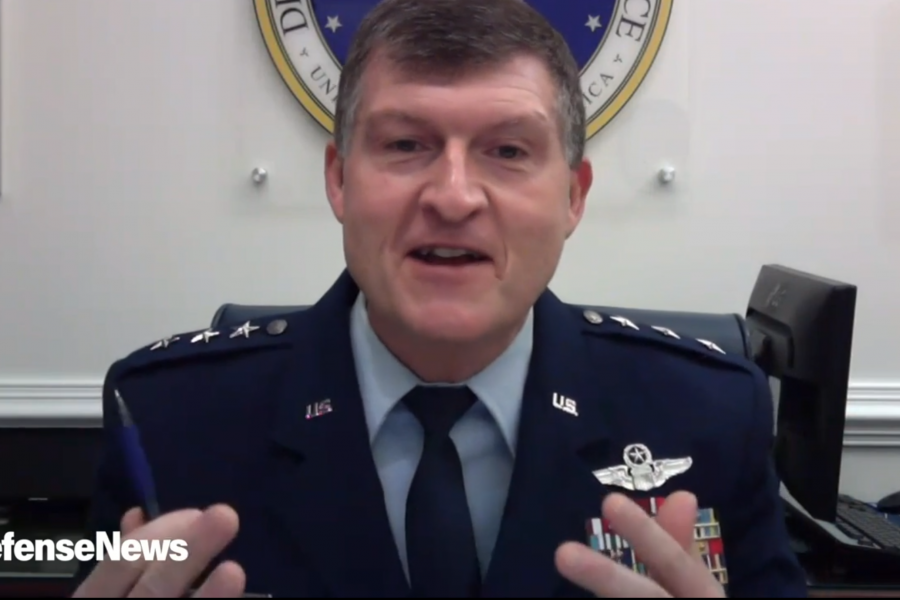The next iteration of the Air Force’s “Future Games,” which explore alternative force structures and capabilities not necessarily in development, will feature swarming drones and munitions launched from cargo planes, as well as the kill chain, according to Lt. Gen. S. Clinton Hinote, deputy chief of staff for strategy, integration, and requirements.
Speaking in a Defense News virtual symposium, Hinote said the exercise, slated to run in late September, allows USAF leaders to experiment with capabilities and concepts that may not be an extant program of record or those that “adhere to … current policies.”
The experiment recognizes that while USAF is still pursuing the “ends” of the National Defense Strategy, “the ‘means’ … may be under a lot more pressure,” Hinote said, echoing comments from other service leaders who expect a no-growth fiscal 2022 budget due to COVID-imposed austerity.
“We have to think very differently about the ways, and what we do in Future Games is we talk about new concepts and new capabilities, how they mate together,” he said.
The exercise will benefit this year from “much more accurate modeling and simulations” and will look specifically at “swarming unmanned vehicles, or palletized munitions.” It will also game “kill chains and … the decision cycle of command and control.” Hinote added, “We have a much better understanding of how to distribute command and control this year than last year when we played this game.”
The adversary in the game will likely try to disrupt command and control, Hinote said, but thanks to joint all-domain command and control, the Army’s Convergence concept, and other initiatives from the services, “I think it’s going to be very difficult for them to disrupt” C2. “We’re not going to be tied to brick and mortar buildings, and we’re going to see a much more fluid” C2 system that “leverages mission command.”
Future Games grew out of Congress’ so-called 1064 report mandating that the Air Force describe the force structure it requires rather than what it thinks the nation can afford, which in turn led to “The Air Force We Need” white paper calling for a 25 percent increase in the size of the service to 386 combat squadrons.
A USAF spokeswoman said the event, expected to be an annual affair, explores the forces “needed inside and outside the highly contested environment to compete with our near-peer adversaries.” Throughout 2019, smaller exercises tested “a hybrid force solution that could fight differently,” she said. The 2020 iteration “will test the hybrid force with an eye toward a more capable and modern Joint Force and enhanced partnerships” that can achieve the ends of the NDS in “different ways, and under a constrained budget.” The exercise is intended to “accelerate change,” she said, while future iterations will help USAF “refine what a feasible force design looks like in coordination with our joint, allied and interagency partners.”
In the next few months, Air Force leadership will try to make the case to “stakeholders,” both within and outside the Air Force, on the need for major changes, as laid out in new Chief of Staff Gen. Charles Q. Brown’s “Accelerate Change Or Lose” white paper.
“We might lose a fight against a peer competitor, fall behind in competition, lose some aspects of the international environment that we’ve relied upon, that our people have benefited from for a long time” without rapid evolution of the force, Hinote said.
“Our equipment is vulnerable, our people may be vulnerable, so we have a pretty stark choice in front of us,” he said, paraphrasing Brown. “He is willing to do what it takes to move forward and accelerate the change we need.”
Though Brown said USAF may see some reorganization, Hinote said it will likely take the form of “flattening, streamlining, and becoming more agile. Certainly at the staff level, that is what we are trying to do … Trying to re-imagine staff work at the Pentagon.” But reorganization “isn’t enough” and “external stakeholders” will have to be convinced that USAF will “think very differently about today’s risk versus tomorrow’s risk.”
Hinote warned that there are “hard choices ahead, things we have to give up, things that are, frankly, good, that work.” However, it’s impossible to take an approach of “bridging” from old technologies to new ones anymore.
“We’ve deferred modernization for so long that the day of reckoning is here, there will be tough decisions … That usually means getting rid of old stuff to get to new stuff.”
He also said USAF is embracing the ideas of acquisition chief Will Roper, who is pushing the service to shift away from systems that must be sustained “30-40-50 years” toward “a design-centric approach, where we use the equipment, we don’t go back and re-build it” in a depot, “but instead we replace it … with something new.”
Digital design has made “incredible strides … in the commercial sector” and has “the potential to change acquisition inside DOD. It allows for the very quick and very accurate redesign of weapon systems, to the point where it’s not always necessary to go back and re-test everything. In fact, your modeling and simulation does a lot of the testing,” Hinote said. The Air Force also seeks to “flip the script” with industry partners to make it “more profitable, a better business value, … to get into a design-centric approach.” He concluded by saying, “You’re going to hear a lot more about that.”
